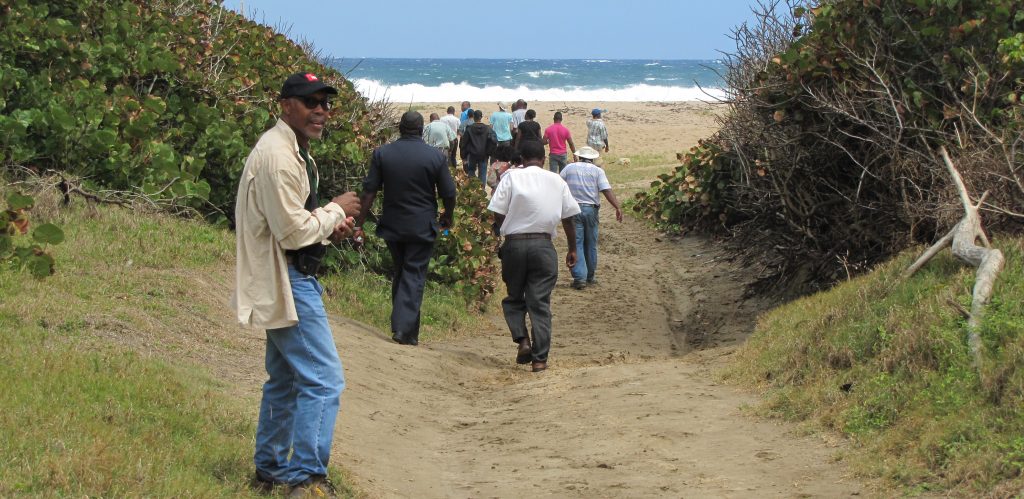
On February 10, 2016 the Ministry of Environment and Drainage, under the direction of the Minister, Dr. Hon. Dennis Lowe coordinate a tour of ecosystems which were especially classified as sites of special interest or of particular important for the purpose of conservation and management. These tours were conducted as part of efforts to fully assess the condition of these ecosystems in light of historical and recent anthropogenric activities, with the purpose of document the challenges faced by agencies in charge of their conservation and restoration and to detail plans going forward for their continued conservation, management and special circumstances, restoration.
The touring party consisted of the following agencies and persons: The Coastal Zone Management Unit, the PM Project Coordination Unit, the Drainage Division, the National Conservation Commission, the National Botanical Gardens, Mr. Rickardo Ward, Ms. Kim Downes Agard, Ms. Nicole Scholar Tasker, Mr. Rohan Payne, Members of the Government Information Service and the Press (Nation, Advocate, Barbados Today) and the Caribbean Broadcasting Corporation.
Turner’s Hall Woods
The tour party was joined by Professors Sean Carrington and Julia Horrocks from the University of the West Indies, members of the Working Group on Biodiversity and Mr. Maynard, a local resident with historical knowledge of the area and its resident flora species. Prof. Sean Carrington gave a brief history of the area. He explained that the Turners Hall Woods represented the last remaining stand of original semi-evergreen moist forest in Barbados. It was originally approximately 50 acres, however due to natural expansion it was now estimated at approximately 74 acres.
Prof. Carrington also noted that this forest is a very species rich site, having never been cleared and is home to a number of plant and animal species found nowhere else on the island. For example, 100 of the 700 flowering plants species in Barbados are found there and also 50 different species of ants.
The widening and clearing of an existing footpath, which runs through the Woods as a connecting thoroughfare, was highlighted. This has resulted in the removal of many mature tree species. The cleared area, now devoid of protective vegetation, had begun to exhibit the effects of rain erosion. The touring party visited this cleared area, with a view to determining the best option for remedial action.
The Minister requested that a project proposal be prepared, focusing on the restoration of Turner’s Hall Woods.
Green Pond
Green Pond/Walkers Savannah is located on the east coast of Barbados in the parish of St. Andrew.
This area is important from a biodiversity perspective, especially for the nesting of marine turtles which are critically endangered. The vegetation at this site is dominated by shrubs for example, crab grass, seaside purge, seaside yam, sage and sea grape.
Professor Horrocks mentioned that the beach between Pico Tenerife and Long Pond is the primary nesting habitat for Critically Endangered leatherback sea turtles in Barbados. The beach is preferred by leatherback backs because of its width and high wave energy. Leatherback nesting is impacted by garbage and by vehicular use of the beach.
Garbage can be buried by females along with their eggs thereby preventing hatchlings from emerging. Vehicles can compress incubating eggs and damage stabilizing beach vegetation. Tyre ruts and garbage containers can trap hatchlings and prevent them from reaching the sea.
It was recommended that the equipment purchased by the NCC to remove Sargassum be utilized for cleaning this wide expanse of beach. Policies and strategies that address solid waste, garbage generation and disposal, as well as at-sea dumping from shipping are also needed to address these issues.
Sand Street
Sand Street is the coastal road immediately to the north of Speightstown. It boasts of a narrow beach which varies in width between the summer and winter months. Since the difference in elevation between the sea level and the road is relatively small coupled with the narrow beach, this street is vulnerable to impacts of climate change.
Over the last 10 years, the seawall has been undermined and overtopped causing structural failure of the existing side walk. The touring party visited this area of vulnerability and discussed possible remedial work, similar to what was constructed at Welches beach in Maxwell.
The solution at Sand Street would be to widen the beach using beach nourishment and appropriate coastal structures to anchor the nourished sand in position. In addition the currently damaged sea wall will have to be removed and replaced with a properly constructed reinforced concrete retaining wall and foundation.







Leave a Reply